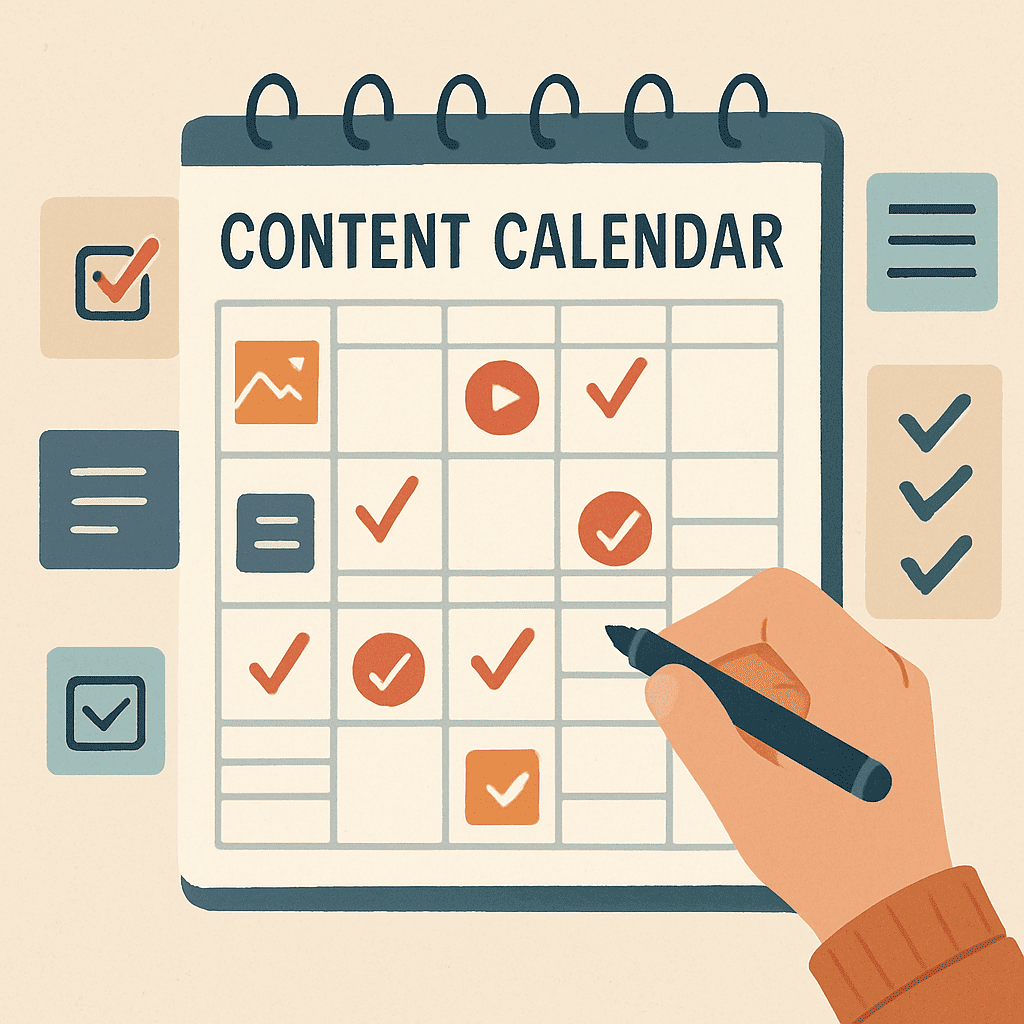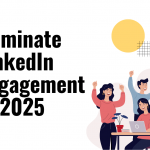
LinkedIn Content Calendar Plan Posts That Drive Conversions in 2025
In today’s fast-paced digital world, having a well organized LinkedIn content calendar is crucial for any business aiming to make a significant impact on LinkedIn. As we look towards 2025, the importance of having a structured LinkedIn content calendar cannot be overstated. It not only ensures consistent posting but also helps in driving conversions by reaching the right audience at the right time.
A LinkedIn content calendar serves as a roadmap for your social media strategy. It helps you plan, organize, and schedule posts in advance, ensuring that your content aligns with your business goals. By using a content calendar, you can maintain a steady flow of engaging posts that resonate with your audience and encourage interaction.
Benefits of Consistency
Consistency in posting is key to keeping your audience engaged. Regularly scheduled content creates a rhythm that your audience can rely on, building anticipation for your posts. Consistent posting also enhances brand recall, making your business a familiar and trusted presence on LinkedIn. Moreover, algorithms favor regular posters, potentially increasing the visibility of your content.
Time Management and Stress Reduction
Planning your content in advance not only saves time but also reduces the stress associated with last-minute posting. A well-structured calendar allows you to allocate resources efficiently, ensuring that content creation does not disrupt other business operations. It provides the freedom to focus on crafting quality content without the constant pressure of deadlines.
Strategic Alignment with Marketing Goals
A content calendar enables you to align your posts with broader marketing and business objectives. By strategically planning your content, you can ensure that each post supports your goals, whether it’s brand awareness, lead generation, or customer engagement. This alignment maximizes the impact of your content efforts, ensuring they contribute to your business’s success.
Enhanced Performance Tracking
Using a content calendar allows for systematic tracking of your content’s performance. By monitoring key metrics such as engagement, reach, and conversions, you can gain insights into what resonates with your audience. This data-driven approach enables you to refine your strategy, focusing on tactics that yield the best results and continuously improving your content’s effectiveness.
Creating an Effective LinkedIn Content Calendar
To create a killer LinkedIn content calendar that drives conversions, follow these key steps:
Step 1: Define Your Goals
Before you start planning your content, it’s important to define what you want to achieve. Are you looking to increase brand awareness, generate leads, or boost sales? Having clear objectives will guide your content strategy and ensure that your posts are aligned with your business goals.
Setting SMART Goals
When defining your goals, ensure they are SMART: Specific, Measurable, Achievable, Relevant, and Time-bound. Specific goals provide clear direction, measurable goals allow you to track progress, achievable goals ensure feasibility, relevant goals align with broader business objectives, and time-bound goals create urgency. This framework helps in crafting a focused content strategy.
Aligning Content with Business Milestones
Consider aligning your content calendar with key business milestones such as product launches, events, or campaigns. This alignment ensures that your content supports critical business activities, maximizing their impact. By planning around these milestones, you can craft timely content that enhances their visibility and success.
Prioritizing Long-term vs. Short-term Goals
Balance your content strategy between long-term brand building and short-term conversions. While immediate results are important, investing in content that builds brand equity over time can yield significant dividends. A well-rounded strategy incorporates both, ensuring sustainable growth and immediate impact.
Step 2: Know Your Audience
Understanding your audience is crucial for creating content that resonates with them. Use LinkedIn analytics to gather insights about your audience’s demographics, interests, and behavior. This information will help you tailor your content to meet their needs and preferences.
Utilizing LinkedIn Analytics
Leverage LinkedIn’s analytics tools to gain deep insights into your audience’s demographics, including age, location, and job roles. Understanding these factors helps in crafting personalized content that speaks directly to your audience. Analytics also reveal engagement patterns, informing the optimal times and formats for posting.
Creating Detailed Audience Personas
Develop detailed audience personas that encapsulate the characteristics of your ideal audience segments. These personas should include demographic information, professional goals, challenges, and content preferences. By personalizing your content to fit these personas, you enhance its relevance and impact.
Engaging in Social Listening
Social listening involves monitoring LinkedIn and other platforms for mentions of your brand, competitors, or industry. This approach provides real-time insights into audience sentiment and emerging trends. By engaging in social listening, you can adjust your content strategy to capitalize on new opportunities and address any potential issues.
Step 3: Plan Your Content Themes

Brainstorming Content Ideas
Hold brainstorming sessions with your team to generate a wide array of content ideas. Encourage creativity and out-of-the-box thinking to develop themes that are both innovative and relevant. By exploring diverse ideas, you can create a rich content mix that keeps your audience engaged.
Aligning Themes with Audience Interests
Use insights from your audience research to align content themes with their interests and pain points. By addressing topics that matter to your audience, you increase the likelihood of engagement and interaction. This alignment ensures your content is not only seen but also valued by your audience.
Rotating Themes for Variety
Rotate themes throughout your content calendar to maintain variety and prevent audience fatigue. By periodically refreshing your themes, you keep your content dynamic and interesting. This approach also allows you to test different themes and identify those that resonate most with your audience.
Step 4: Choose the Right Content Types
Mixing different types of content keeps your audience engaged. Consider using a variety of formats such as:
- Articles: In-depth pieces that provide valuable insights.
- Videos: Engaging content that captures attention.
- Infographics: Visual content that simplifies complex information.
- Polls and Surveys: Interactive content that encourages engagement.
Exploring Diverse Content Formats
Explore a wide range of content formats beyond the basics, such as webinars, podcasts, and live Q&A sessions. Each format offers unique engagement opportunities and appeals to different audience preferences. By diversifying your content types, you cater to varied consumption habits, broadening your reach and impact.
Balancing Evergreen and Timely Content
Balance your content strategy between evergreen content that remains relevant over time and timely content that capitalizes on current events or trends. Evergreen content builds a lasting knowledge base, while timely content drives immediate engagement. This balance ensures a robust and responsive content strategy.
Utilizing Interactive Content
Incorporate interactive content like quizzes, polls, and contests to enhance engagement. Interactive content invites participation, making your audience active contributors rather than passive consumers. This approach fosters deeper connections and provides valuable insights into audience preferences and opinions.
Step 5: Schedule Your Posts
Once you have a clear idea of your content themes and types, it’s time to schedule your posts. Use a content calendar template to organize your posting schedule, ensuring a consistent flow of content. Consider the best times to post on LinkedIn, which can vary based on your audience’s activity.
Optimizing Posting Frequency
Determine the optimal posting frequency for your audience by testing different schedules and analyzing engagement data. While consistency is key, too frequent posting can overwhelm your audience, while infrequent posting may lead to disengagement. Finding the right balance is crucial for sustained audience interest.
Timing for Maximum Engagement
Identify the best times to post on LinkedIn by analyzing when your audience is most active. Experiment with different posting times and use LinkedIn analytics to track engagement metrics. Posting during peak activity times enhances visibility and increases the likelihood of engagement and interaction.
Automating Scheduling with Tools
Use scheduling tools to automate your posting process, ensuring timely and consistent content delivery. Tools like Hootsuite or Buffer allow you to queue posts in advance, freeing up time for strategic planning and content creation. Automation enhances efficiency while maintaining the quality of your content strategy.
Step 6: Monitor and Adjust
After your content is live, it’s important to monitor its performance. Use LinkedIn analytics to track key metrics such as engagement rates, click-through rates, and conversions. This data will help you identify what’s working and what needs improvement, allowing you to adjust your strategy accordingly.
Analyzing Key Performance Indicators (KPIs)
Identify the key performance indicators (KPIs) that align with your content goals, such as engagement, reach, and conversion rates. Regularly analyze these metrics to assess the effectiveness of your content strategy. By focusing on KPIs, you can make informed decisions that drive continuous improvement.
A/B Testing for Optimization
Conduct A/B testing to compare different content variations and determine which performs best. Test variables such as headlines, images, and call-to-action (CTA) phrasing to identify the most effective elements. A/B testing provides data-driven insights that enhance the precision and impact of your content.
Continuous Learning and Adaptation
Adopt a mindset of continuous learning and adaptation, using insights from performance analysis to refine your strategy. Stay updated on LinkedIn’s algorithm changes and industry trends, incorporating new tactics as needed. This proactive approach ensures your content remains relevant and effective in achieving your goals.
Tools for Building a LinkedIn Content Calendar

Several tools can assist in building and managing your LinkedIn content calendar:
- Trello: A versatile tool for organizing and scheduling content.
- Buffer: Allows you to schedule and publish posts across multiple platforms.
- Hootsuite: Offers comprehensive social media management features.
- CoSchedule: Provides a dedicated marketing calendar feature for efficient planning.
Choosing the Right Tool for Your Needs
Evaluate different tools based on your specific requirements, such as team collaboration, analytics capabilities, and budget. Each tool offers unique features, so assess their functionalities with your content strategy. Selecting the right tool enhances your ability to manage and execute your content calendar effectively.
Integrating Tools for Seamless Workflow
Consider integrating multiple tools to create a seamless workflow that covers all aspects of content planning and execution. For instance, use Trello for planning, Buffer for scheduling, and Hootsuite for monitoring. Integration ensures that each tool complements the others, maximizing efficiency and effectiveness.
Leveraging Advanced Features
Explore and leverage the advanced features of your chosen tools to enhance your content strategy. Features such as analytics dashboards, automation, and team collaboration can significantly improve your content management process. By fully utilizing these capabilities, you can optimize your content calendar for superior results.
Best Practices for LinkedIn Content Calender in 2025
To ensure your LinkedIn content calendar is effective in 2025, consider these best practices:
Focus on Quality Over Quantity
In 2025, quality content will be more important than ever. Focus on creating high-value posts that provide insights, solve problems, or offer new perspectives. This approach not only attracts more engagement but also builds your authority in your industry.
Crafting Thought Leadership Content
Position yourself as a thought leader by sharing expert insights and innovative ideas in your content. Thought leadership content establishes your authority and credibility, attracting a loyal following. By consistently delivering valuable insights, you enhance your reputation and influence within your industry.
Prioritizing Audience-Centric Content
Develop content that is centered around your audience’s needs and interests, rather than solely promoting your products or services. Audience-centric content fosters genuine connections and engagement, as it demonstrates your commitment to providing value. This approach builds trust and encourages long-term relationships.
Ensuring Content Authenticity
Authenticity is crucial for connecting with audiences in an era of information overload. Share genuine stories, experiences, and perspectives that reflect your brand’s values and identity. Authentic content resonates more deeply with audiences, fostering trust and loyalty.
Leverage User-Generated Content
User-generated content (UGC) is a powerful way to build trust and authenticity. Encourage your audience to share their experiences with your products or services and feature their content on your page. UGC not only enhances engagement but also provides social proof.
Encouraging Audience Participation
Actively encourage your audience to create and share content related to your brand. Launch campaigns or contests that incentivize participation, making it easy and rewarding for users to contribute. By fostering participation, you create a community around your brand and amplify your reach.
Highlighting Customer Success Stories
Feature customer success stories as part of your UGC strategy to demonstrate the real-world impact of your products or services. These stories provide tangible proof of your brand’s value and effectiveness, enhancing credibility. Sharing customer experiences also humanizes your brand, making it more relatable.
Building a Community Through UGC
Use UGC to build a sense of community and connection among your audience. By showcasing diverse voices and perspectives, you create a platform for shared experiences and dialogue. This community-building approach strengthens brand loyalty and encourages ongoing engagement.
Incorporate AI and Personalization
As technology advances, incorporating AI and personalization into your content strategy can give you a competitive edge. Use AI tools to analyze data and create personalized content that meets the specific needs of your audience. This approach enhances user experience and drives conversions.
Leveraging AI for Data Analysis
Utilize AI-powered tools to analyze vast amounts of data and uncover actionable insights about your audience. AI can identify patterns and trends that inform your content strategy, enabling more precise targeting and messaging. By leveraging AI, you enhance the accuracy and effectiveness of your content efforts.
Creating Personalized Content Journeys
Craft personalized content journeys that guide users through tailored experiences based on their preferences and behaviors. Personalization increases relevance and engagement, as users receive content that aligns with their unique needs. This tailored approach enhances user satisfaction and encourages deeper interactions.
Implementing AI-driven Automation
Integrate AI-driven automation to streamline content creation, distribution, and optimization processes. Automation frees up resources for strategic planning and creative development, while ensuring consistent delivery of personalized content. By embracing AI automation, you enhance efficiency and responsiveness in your content strategy.
Engage with Your Audience
Engagement is key to building relationships on LinkedIn. Respond to comments, participate in discussions, and reach out to your audience with personalized messages. This proactive approach strengthens your connection with followers and encourages them to engage with your content.
Facilitating Meaningful Conversations
Encourage meaningful conversations by posing thoughtful questions and inviting audience input in your content. Engage in active listening and respond authentically to comments and feedback. By facilitating dialogue, you build a sense of community and deepen your relationships with your audience.
Personalizing Audience Interactions
Personalize your interactions with audience members by addressing them by name and acknowledging their contributions. Tailored responses demonstrate your appreciation and commitment to individual connections, fostering loyalty. Personalization enhances the quality of engagement, making it more impactful and memorable.
Encouraging User-Generated Discussions
Create opportunities for user-generated discussions by encouraging followers to share their perspectives on relevant topics. Host LinkedIn Live sessions or group discussions where audiences can interact directly with your brand and each other. These discussions build community and amplify engagement through shared experiences
A well-planned LinkedIn content calendar is an indispensable tool for driving conversions in 2025. By defining your goals, understanding your audience, and using the right tools and strategies, you can create a robust content calendar that keeps your audience engaged and supports your business objectives. Stay ahead of the competition by focusing on quality, leveraging user-generated content, and embracing the latest technological advancements in your content strategy.
With these insights, you’re well-equipped to create a LinkedIn content calendar that not only enhances your brand presence but also drives meaningful business results. Happy planning!


